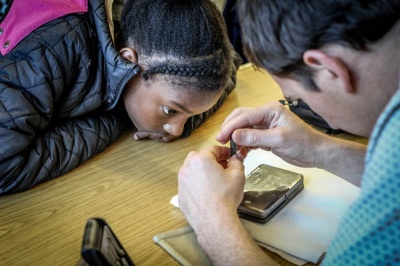Circular cities are doing it for themselves
With European guidance still going through the bureaucratic process and national policy seemingly well down the pecking order, local and regional authorities can take the reins and steer their areas into a more circular way of living.
Brexit has put a significant scare up the waste and resources industry as stakeholders wait to see what environmental regulations will survive the transfer from EU to UK law, which new European legislation will be taken on during the break-up and what approach the UK will take post-separation. But while the government is looking to Brussels, local authorities in the UK are keen to get on with moving to a circular economy and reaping the benefits of actions on waste prevention and reuse.

The circular economy
The circular economy is one that disrupts the typical ‘linear’ way of treating resources: take from the ground, make into a product and then dispose of the item. By finding ways of remanufacturing, reusing or recycling materials and keeping them in use for longer we can cut down on resource use. The idea emphasises ecodesign for durability and modularity, utilising under-used assets through sharing and offering products as a service.
The past few years have seen movement on circular measures on a European scale. The European Union’s Circular Economy Package promises the development of standards and regulations to help improve ecodesign, the quality of secondary raw materials and plastics, as well as a range of recycling – and potentially reuse – targets, designed to drive materials up the waste hierarchy.
However, the targets and tools that are provided by the package will only be fully utilised if the UK creates a national strategy to get the country moving in the same direction. Brexit and the uncertain future for trade and export make it more pressing that we have a plan to fully realise the employment, supply and commercial benefits of a circular economy. The circular economy, WRAP research has shown, would give a massive boost to the intermediate labour market, and reduce unemployment by up to 102,000 by 2030 and potentially offset around 18 per cent of the expected loss in skilled employment over the next decade.
Local authorities must take the lead
With the Brexit process well afoot, and the department constantly undergoing budget cuts, Defra’s work capacity is being pushed to its limits, and new strategies are unlikely to be forthcoming any time soon. It is therefore cities, regions and local authorities, already ready and willing to begin the transition, that must take the lead.
Half of the world’s population lives in cities today, a figure that is set to rise to 60 per cent by 2030, according to the United Nations. This rapid clustering of people is putting pressure on resources, air quality, the living environment and public health. Indeed, cities occupy just three per cent of the Earth’s land, but account for 60-80 per cent of energy consumption and 75 per cent of carbon emissions, which is why creating resilient and sustainable cities is one of the UN’s Sustainable Development Goals. But this population concentration also means that we have ready-made hubs to focus innovation to reduce resource and energy consumption.
Local authorities are under constant pressure to cut down on expenditure, and their resources to experiment with innovation are often miniscule, but with a closer relationship with residents and the SME business sector – two of the main players in a local circular economy – they are positioned perfectly to take the first steps.
London aims to become the ‘best circular economy city’
The London Waste and Recycling Board (LWARB) was created by the Greater London Assembly to promote waste reduction and waste management that can benefit London’s environment. Wayne Hubbard, Chief Operating Officer of LWARB, says that London is on the path to become the world’s leading circular economy hub. By stimulating innovation in areas like remanufacturing and new, resource-efficient business models, London is looking at benefits of at least £7 billion every year by 2036, as well as the creation of over 40,000 new jobs (12,000 net) in circular sectors.

Speaking at the North London Waste Authority’s Waste Prevention Exchange in February, Hubbard noted: “We want London to be the world’s best circular economy city, but it’s great that across Europe there are a bunch of cities and regions that have identified it [as a priority]. Most people live in cities now, so cities are important: cities are going to drive this agenda forward – not European institutions or national governments, but cities.”
Growth in cities like London over the next two or three decades will bring with it waste management challenges, but Hubbard says that it should not be considered a given that cities should just plan for an increase in waste. By considering the implications of a more circular economy, local authorities could even plan for waste, in the traditional sense, to go down, with a “different style” of waste management facilities that we might not even consider waste management today.
LWARB is looking to unlock this potential by focusing on five specific areas – the built environment, food, textiles, electrical equipment and plastics, all pathways that the organisation thinks could unlock billions of pounds for the UK economy by 2036. This spring, LWARB will publish a route map, charting the path to a circular London in those five key areas that is being developed with stakeholders. Through around 100 short, medium and long-term actions, covering both the private and public sectors, the route map will act as a starting point for the transition, showing that there’s plenty that local and regional authorities can do.
Examples of the interventions suggested by London include innovations for modular construction, raising consumer awareness and knowledge of food waste and security, helping to create product sharing models and increasing the reuse and repair of clothes through incentivised return schemes.
Inter-city competition and collaboration
The determination to reap the circular benefits across city governments means that collaboration (and healthy competition) will help drive cities to take on more and more circular ambitions.
In Paris, for example, the Mairie de Paris has published a white paper on a circular economy for the Greater Paris Metropolis, a group of 124 municipalities with a population of nearly seven million. Like London, Paris is split into a number of different local government authorities, but the white paper was created with 21 local authorities and 240 participants assembled across a number of working groups, showing how separate local bodies can come together to create a wide-ranging and powerful regional whole.
The paper foresees ‘an economy that encourages new forms of production and consumption, as well as sociability, sharing and democracy, as opposed to a short-term profit and consumerist diktat’. And with the urban environment so firmly intertwined, the paper suggests that ‘the densely populated Parisian metropolis, with its tightly woven logistics network, abundant resources and businesses, represents an important echelon and promising ground for the circular economy’.
The French capital is trying to find new ways of bringing the circular economy into the city: municipal uniforms are getting recycled, construction contracts are being built around sustainable principles, even an action as simple as restricting traffic on the road running along the right bank of the Seine has created an environment where small circular businesses like bicycle repair shops and ‘circular eateries’ can thrive.
Putting resource efficiency ‘front and centre’
It is businesses like these that cities need in order to make resource efficiency not just something that is tied up in the operations of councils and waste management but which is front and centre in the lives of residents. Rather than central governments, which need to accommodate a varied landscape of industries, commercial centres and demographics, it is cities and local authorities that can know their specific situation and dictate what their public see every day and bring about positive behaviour change.
So, whether that is through helping a restaurant using surplus food from supermarkets to meet regulatory conditions and find suitable premises, utilising council platforms to promote refurbished furniture and clothes shops or providing financial support to get a start-up off the ground, local authorities can give circular businesses a boost and change the way their residents view resources.
Hubbard explains: “The benefits for cities of accelerating a circular economy are huge, and in London we recognise that we need to seize the opportunity. Cities have a significant role to create the right conditions for circular economy businesses to flourish. And because the circular economy is being led by businesses and consumers – taking advantages of new ways of consuming and sharing enabled by technology – it can be achieved through a variety of means that can flourish regardless of the policy landscape.”
LWARB’s Advance London programme is looking to support circular businesses from start-up to maturity, allowing them to find their place in the economy and realise their potential. As well as establishing funding for circular economy businesses, the organisation hopes to establish accelerator and incubator activity alongside corporate, academic and public-sector partners, as well as a hub where SMEs can share ideas and results to spread circular knowledge.

As Miranda Schnitger, Project Manager at the Ellen MacArthur Foundation, explained at the Waste Prevention Exchange event, companies across the world are working towards a RESOLVE framework (projects that REgenerate resources, Share assets, Optimise system performance, keep products and materials in the Loop, Virtualise resource use and services and Exchange resources and technology more wisely).
Schnitger points to the example of The Library of Things in South London, which enables anyone to borrow DIY tools, gardening equipment, kitchenware, camping kit and lots more. These products often sit in cupboards, used every now and then, until they break or become obsolete, often after only a few uses. Local authorities could help projects like this by finding premises and helping promotion to begin the trend of resource efficiency in their areas. The more people buy into the circular economy and waste prevention, the more other members of the public and governments will begin to take note.
Making circular moves in smaller authorities
The circular economy is not just a plaything for large capital cities, and though resources might be stretched in smaller local authorities, they can still make advances in circular strategies and actions.
Kalundborg in Denmark, for example, a city of just 16,000, has become the poster child for industrial symbiosis, creating an industrial ecosystem that uses a commercial collaboration of public and private enterprises to create a closed system of resources. Waste bioethanol from the Inbicon biorefinery, for example, is used by energy company Statoil, which provides used cooling water to Danish energy giant DONG. The result of the development is a group of 11 companies turning 29 different waste streams into another company’s gold, with strong commercial benefits for everyone involved.
In the UK, in Peterborough, one of the Ellen MacArthur Foundation’s Circular Cities, a similar project has been established in the Fengate business cluster as part of the circular Peterborough DNA programme. Beginning with a core group of 12 businesses, the network now consists of more than 100 businesses swapping items that they need to discard or can share in exchange for ones they need.
Sharing knowledge
The trick to establishing good waste prevention practices in smaller authorities is to take note of what has been successful elsewhere, and there are several networks that aim to spread good circular practice across the globe: the Ellen MacArthur Foundation’s Circular Cities Network and CE100 Government and Cities Programme offer multi-stakeholder collaboration to provide opportunities for circular transition, while the Circular Europe Network (CEN), run by ACR+, supports local and regional authorities to adopt ambitious circular economy strategies by gathering, analysing and exchanging information on programmes run throughout Europe.
Philippe Micheaux Naudet, the Senior Project Manager of the CEN, said: “The EU has been a key instrument to push member states but also local and regional authorities to develop always more ambitious policies and practices.

“ACR+ will continue to facilitate exchanges of good practices, the sharing of technical knowledge and capacity building activities, including for the benefits of our UK based members. We had and we still do have members who are not in the European Union and cooperation has always been possible. What will significantly change with Brexit though will be access to EU funding and the impact of national legislation.
“For the time being, circular economy is really high on the agenda and the European Union set up an important financial supportive framework for actions on that topic. At the same time the EU legal framework provides a common basis for action with at least a minimal range of rules and targets. Cooperation remains key at all levels because issues like the environment know no border. We need to continue our efforts to all move in the same direction despite political and administrative changes.”
Green public procurement
Even local authorities that are under increasing pressure to cut costs and don’t have the resources to create funding or support programmes – most, if not all, of them – can use their core functions to bring about change.
Indeed, local authorities can give a big push to circularity through green public procurement, with public procurement accounting for some £268 billion of goods and services across the UK, approximately 15 per cent of the nation’s gross domestic product. This presents a huge amount of potential for greening should councils take on policies that furniture will be second-hand, foodservice equipment will be reusable and the only electronic equipment purchased will be easily repairable. On a regional level, there is the opportunity to utilise more collaborative procurement for equipment and services that are not used daily and mitigate the budget constraints of sustainable procurement. Having such a large revenue and capital stream diverted towards circular practices would give those resource-efficient business models a real shot in the arm.
Local planning and building regulations is another area where progress could be made, finding ways of getting developers to compensate for the impact of their construction. At the Old Oak and Park Royal development in West London, for instance, LWARB is conducting a study to investigate how to integrate circular economy principles into the built environment, be that through sourcing of materials, the management of waste and the use of vertical farms and green roofs. This is something that can be implemented at local authorities of any size, and these green additions to developments can help bring nature back into the urban environment, with benefits to both physical and mental health – again showing how circular practices have more than just an environmental benefit.
Pushing waste up the hierarchy
Another speaker at the NLWA Waste Prevention Exchange, Dr Dominic Hogg, Founder and Chairman of Eunomia Research & Consulting, looked at how local authorities could use their core functions to make circular changes based on waste prevention. He estimated that in 2016, around £3.5 billion was spent by local authorities on waste operations, but just £15 million of that was on waste prevention. Despite the waste hierarchy telling us that prevention is the number one priority, funding follows the capital, which in waste is dominated by the bottom of the hierarchy, with disposal, energy from waste and recycling.
This is unlikely to change any time soon, as weight-based targets from Europe and the priorities of the industry, as well as the difficulty in measuring reuse and waste prevention, mean that resources are concentrated on those projects, but could we be more creative in packaging projects higher up the waste hierarchy so that they are more attractive to funders?

Community ventures like The Restart Project, which puts on events where members of the public can bring broken or faulty technology and see it fixed by trained volunteers, provides a positive social aspect, as well as teaching skills and building confidence in DIY repair. They can also inspire, with a network of similar groups like the Hackney Fixers spinning off from the Restart project. So, in addition to the benefits that such projects bring to resource management and the environment, circular SMEs can also incorporate other social bonuses that energy recovery and landfill simply cannot.
Hogg suggests that by adding a consideration to waste prevention activities in council policy and practice, the circular economy could bring not only lower costs to authorities, improved quality of assets and better employment, but also better gross value added for communities, more jobs, and better health through reduction in greenhouse gas emissions and improved air quality.
Local authorities have the ear of the public and clearly have a hunger to welcome a circular economy and the benefits that come along with it. Rather than sitting around and waiting for national and European policy to trickle down to a regional level, it is cities that can make the first steps, large or small, towards making circularity a prominent part of daily life.





